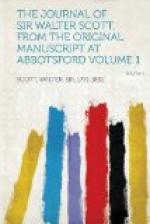8. The last will and testament of Cormac-mac-Cuilinan in verse.
9. The various forms of the Ogham.
10. The death of Cuchullin, an antient story interspersed with poems, which, if collected, would contain the entire substance of the composition, which is very good (except in one instance) and founded on real fact.
11. The bloody revenge of Conall Cearnach for the death of Cuchullin. This may be considered as the sequel of the preceding story, and of equal authority and antiquity. It is written in the very same style, and contains a beautiful elegy on Cuchullin by his wife Eimhir.
12. The death of Cormac Con luings, written in the same style with the foregoing stories.
13. The genealogies of all ye principal Irish and Anglo-Norman families of Ireland to the end.
14. A very good copy of the Cath-Gabhra.
The above table of contents is in the handwriting of Dr. Matthew Young, late Bishop of Clonfert, a man possessing the highest talents and learning, and who had been acquainted with the Irish language from his infancy. J.B.
* * * * *
No. IV.
“A Former Empress.”—P. 451.
The Church of Santa Maria del Carmine contains relics dear alike to the romance of democracy and empire. It was from this church that Masaniello harangued the fickle populace in vain; it was here that he was despatched by three bandits in the pay of the Duke of Maddaloni; and here he found an honourable interment during a rapid reflux of popular favour. In this church, too, lies Conradin the last prince of the great house of Suabia, with his companion in arms and in death, Frederic, son of the Margrave of Baden, with pretensions, through his mother, to the Dukedom of Austria. The features of the mediaeval building have long since been obliterated by reconstructions of the 17th and 18th centuries, while round the tomb of Conradin a tissue of fictions has been woven by the piety and fondness of after times. The sceptics of modern research do not, however, forbid us to believe that there may be an element of truth in the beautiful legend of the visit and benefactions of Elizabeth Margaret of Bavaria, the widowed mother of Conradin, erroneously dignified with the title of Empress, to the resting-place of her son. Her statue in the convent, with a purse in her hand, seems to attest the tale, which was no doubt related to the Scottish Poet, and may well have stirred his fancy. What the epitaph was which he copied we cannot now determine. It is not pretended that the unhappy lady was buried here, but two inscriptions commemorate the ferocity of Charles of Anjou, and the vicissitudes of fortune which befell his victims. One, believed to be of great antiquity, is attached to a cross or pillar erected at the place of execution. It breathes the insolence of the conqueror mingled with a barbarous humour embodied in a play on words—for “Asturis” has a double reference to the kite and to the place “Astura,” at which the fugitive Princes were captured:




